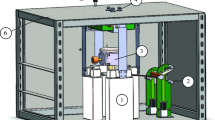Abstract
Exploding wires can deposit significant amounts of energy on nS–µS timescales into a confined space. Most exploding wire studies have been performed in air but we have started to investigate enclosing the wire element in solid matrices like concrete to mimic the effects of an underground nuclear explosion. Temperatures and pressures achieved are quite sufficient to induce structural cracking and localized flash melting. As a result exploding wires would appear to form the perfect trigger for releasing chemical species in geological media to study migration behavior. Details of the apparatus and some illustrations of its potential will be given.







Similar content being viewed by others
References
Gladstone S, Dolan PJ (1977) The effects of nuclear weapons. U.S. Department of Defense and the Energy Research and Development Administration, Arlington County. ISBN 978-1-60322-016-3
McGrath JR (1966) Exploding wire research 1774–1963. Naval research laboratory report 1698, Washington, DC, USA
Bellis II, Shashurin A, Baksht RB, Oreshkin V (2009) Density and temperature distributions in the plasma expanding from an exploding wire in Vacuum. J Appl Phys 105:033301. https://doi.org/10.1063/1.3050343
Collins GW, Valdivia MP, Zick T, Madden RE, Haines MG, Beg FN (2013) Study of X-pinch dynamics using a low current (25 kA) and slower current (400 ns) pulse. Phys Plasmas 20:042704. https://doi.org/10.1063/1.4798389
Sarkisov GS, Caplinger J, Parada F, Sotnikov VI (2016) Electrical explosion of Al and Ag wires in air at different pressures. J Appl Phys 120:123303. https://doi.org/10.1063/1.4963117
Kotov YA (2003) Electric explosion of wires as a method for the preparation of nanopowders. J Nanopart Res 5:539–550
Fedotov A, Sheftman D, Gurovich VT, Efimov S, Bazilitski SG, Krasik YA, Oreshkin VI (2008) Spectroscopic research of underwater electrical wire explosions. Phys Plasmas 15:082704. https://doi.org/10.1063/1.2973176
Li X, Chao Y, Wu J, Han R, Zhou H, Qiu A (2015) Study of the shock wave characteristics generated by underwater electrical wire explosion. J Appl Phys 118:023301. https://doi.org/10.1063/1.4926374
Katzenstein J, Sydor M (1962) Exploding wires as fast dynamic pinch. J Appl Phys 33:718–722
Lochte-Holtgreven W (1987) Research on nuclear reactions in exploding (Li + LiD) wires. Z Naturforsch 42a:538–542
Widom A, Srivastava YN, Larsen L (2007) Energetic electrons and nuclear transmutations in exploding wires. arXiv: 0709.1222v1
Cho C, Choi YW, Chang CW, Lee GW (2007) Effects of the medium on synthesis of nanopowders by wire explosion process. Appl Phys Lett 91:141501. https://doi.org/10.1063/1.2794724
Han R, Zhou H, Liu Q, Wu J, Jing Y, Chao Y, Zhang Y, Qiu A (2015) Generation of electrohydraulic shock waves by plasma-ignited energetic materials: 1. Fundamental mechanisms and processes. IEEE Trans Plasma Sci 43:3999–4008
Nazarenko O (2007) Nanoparticles produced by electrical explosion of wire. In: Proceedings of the European congress of chemical engineering (ECC-6), Copenhagen, Sept 16–20
Nash CP, McMillan WG (1961) On the mechanism of exploding wires. Phys Fluids 4(7):911–917
Chace WG (1964) Exploding wires. Phys Today 17(8):19–24
Taylor MJ (2002) Formation of plasma around wire fragments created by electrically exploded copper wire. J Phys D Appl Phys 35:700–709
Carman AJ, Liezers M, Eiden GC (2018) Remote sensing of volatile elements for new signatures from underground nuclear explosions. In: Methods and applications radio analytical chemistry conference, Kailua-Kona, Hawaii USA, April 8–13, 2018, submitted to J Radioanal Nucl Chem
Wilmarth VR (1959) Some effects of underground nuclear explosions on tuff. Report USAEC TE1-756
Schwartz L, Piwinskii A, Ryerson F, Tewes H, Beiriger W (1984) Glass produced by underground nuclear explosions. J Non Cryst Solids 67:559–591
Lide DR (1997) CRC handbook of chemistry and physics. CRC Press, Boca Raton. ISBN 0-8493-0478-4
https://www.inorganicventures.com/common-problems-hg-au-si-os-and-na. Accessed 14 July 2018
Karioris FG, Fish BR (1962) An exploding wire aerosol generator. J Colloid Sci 17:155–161
Bien F (1973) Evaluation of atmospheric release techniques for atomic uranium and thorium. National technical information service report AD-768 624, pp 25–29
Holcombe JA, Sacks RD (1973) Exploding wire excitation for trace analysis of Hg, Cd, Pb and Ni using electrodeposition for preconcentration. Spectrochim Acta 28B:451–487
Composition of Air. Universal Industrial Gases Inc. http://www.uigi.com/air.html. Accessed 14 Mar 2018
Acknowledgements
This work was funded by the Office of Defense Nuclear Nonproliferation Research and Development with the U.S. Department of Energy’s National Nuclear Security Administration under contract DE-AC05-75RLO1830. The views, opinions and findings contained within this paper are those of the authors and should not be construed as an official position, policy or decision of the DOE unless designated by other documentation.
Author information
Authors and Affiliations
Corresponding author
Rights and permissions
About this article
Cite this article
Liezers, M., Carman, A.J. & Eiden, G.C. Simulating the effects of underground nuclear explosions with an exploding wire. J Radioanal Nucl Chem 318, 79–87 (2018). https://doi.org/10.1007/s10967-018-6047-2
Received:
Published:
Issue Date:
DOI: https://doi.org/10.1007/s10967-018-6047-2




